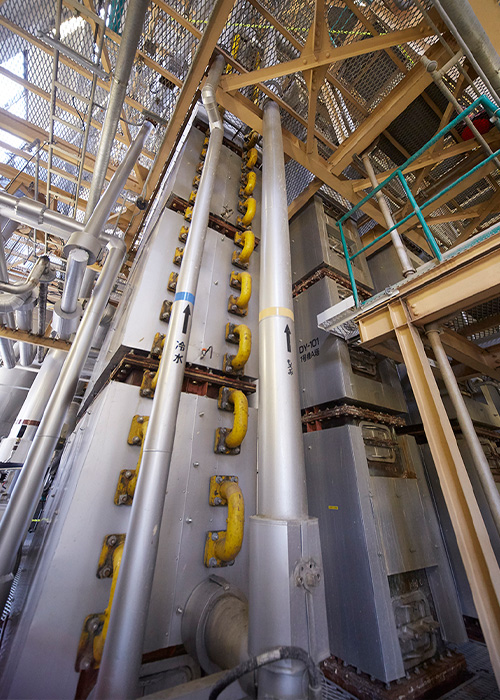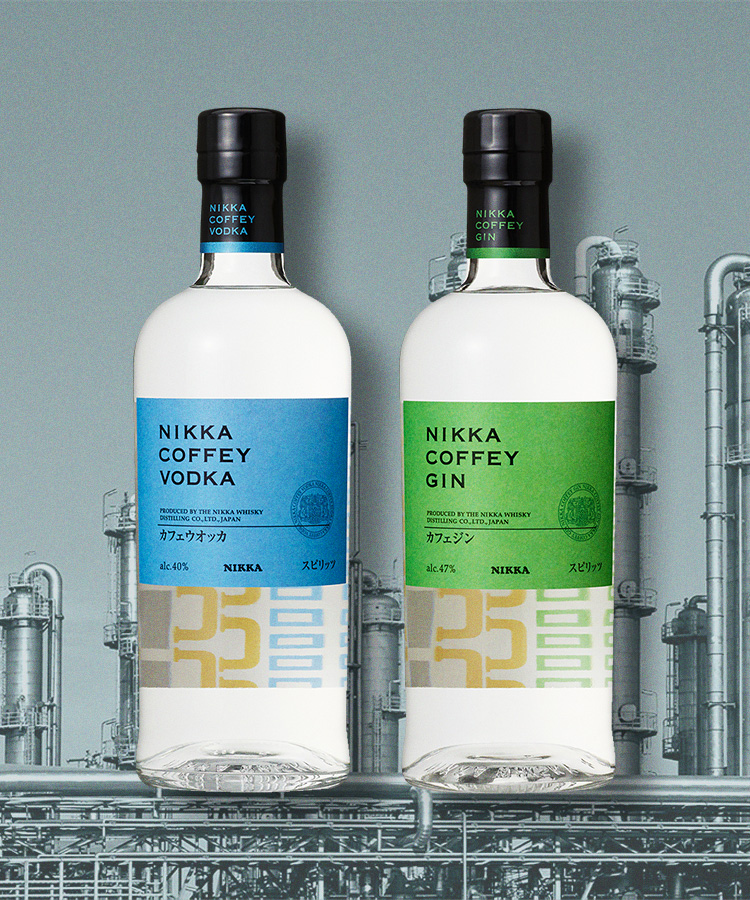
Nikka is one of the most respected whisky distillers in Japan, and has been for more than nine decades. Founded by Masataka Takesturu in 1934, Nikka has stayed true to his philosophy of marrying tradition and innovation. Although he didn’t live to see it, his philosophy is perhaps most evident in Nikka’s gin and vodka, both introduced in 2017. They’re innovative, to be sure, but it’s not because cutting-edge technology is used to make them. Quite the opposite, in fact. They’re both made using 19th-century technology with equipment with a name that can, because of how it’s pronounced, be misleading for people who don’t know the story behind it.
Nikka Coffey Gin & Coffey Vodka — What Does “Coffey” Mean?
Let’s get one misconception clear right off the bat — though it sounds like the word coffee, Nikka’s Coffey Gin and Coffey Vodka are not coffee-flavored! (Neither are their Coffey Grain or Coffey Malt whiskies, for that matter.) The “Coffey” in the name refers to the type of still that’s used to distill them. The still is named for its inventor, Aeneas Coffey, who patented it in Dublin in the early 1830s. Today’s column stills work under the same basic principles as the Coffey still, though of course they’ve advanced technologically by leaps and bounds, making distillation cleaner and more efficient with less manual labor involved. So why does Nikka still use and maintain one of the last functional Coffey stills in the world? Because they make better tasting spirits — and for Nikka, quality, and meticulous attention to every detail of the distilling and blending process, is more important than doing things easily or quickly.
But why is such an antiquated piece of equipment still the gold standard for distillation? Read on!
Transforming How Spirits Are Distilled
The invention of the Coffey still was one of the most transformative developments in the history of distilled spirits. Before then, distillation had been implemented entirely on pot stills, which made — and still make — complex, flavorful spirits. But they can also be quite inefficient, as only one batch of spirits is able to be distilled at a time. It’s also difficult to control consistency of quality and flavor using a pot still alone.
Enter the Coffey still. Functioning like a series of pot stills, the column-shaped still heats the wash — which is, at this point, essentially beer — and, using a series of plates stacked at intervals atop each other, separates and purifies the alcohol, which boils at a lower temperature than water. The alcohol vapor is then run through a rectifier, which cools and liquefies it. A big advantage of the Coffey still is that distilled spirit can be removed from the rectifier while the other column, known as the analyzer, is still operating. Today, the imprint of the Coffey still is known by different names, including column still, continuous still, and patent still, all designed to produce high-purity spirits more efficiently.
One of the Rarest Stills in Existence
The Coffey still at Nikka — one of the very few of this original design left in the world that’s still in working order — was brought to the Nishinomiya distillery by Masataka Taketsuru in 1963 from Scotland, where, decades before, he had learned the craft of distilling whisky. It was the first working Coffey still in Japan. Since then, it’s been used as a vital component in Nikka’s whiskies. The Coffey still moved to its current home, the Miyagikyo Distillery, in 1999. In the 2010s Coffey Grain and Coffey Malt whiskies, distilled entirely on the Coffey still, were launched. Because of consumer demand for clear Japanese spirits, 2017 saw the introduction of new innovations — Nikka Coffey Gin and Coffey Vodka.

Today’s column stills are descended from the Coffey still, but they’re a lot more technologically advanced, requiring much less supervision and hands-on monitoring, with the ability to distill alcohol to a higher proof and greater purity than Aeneas Coffey could have dreamed of a couple hundred years ago. As a result, the vast majority of the early Coffey stills were junked in favor of advanced technology. Weirdly enough, though, those old-school Coffey stills — made entirely of copper, unlike today’s copper-lined steel stills — make better tasting spirits because of their limitations. They’re not able to distill alcohol quite as efficiently as modern stills, but that inefficiency winds up producing spirits with a silkier texture, fuller body, and more complexity of flavor, retaining more of the character of the distillate. And that makes for truly extraordinary gin and vodka.
If Coffey Gin & Coffey Vodka Have Nothing to Do With Coffee, How Do They Taste?
Nikka Coffey Gin and Coffey Vodka are made from the same base spirit — corn. The Vodka is lightly filtered with white birch charcoal. This results in a rich sweetness with zesty citrus notes and milky mouthfeel, a fuller flavor than vodkas made in column stills.
Coffey Gin goes through the same process, with a couple of added steps: Botanicals are added to the distillate via different methods including steeping and vacuum distillation. The mix includes 11 different botanicals, from traditional juniper, angelica, and coriander to four different kinds of Japanese citrus, as well as apples and Japanese green Sansho pepper. After the botanicals have been added, the gin is redistilled, blended and filtered. The silky texture from the Coffey still distillate and the balance of the botanicals produces a bright and aromatic flavor profile of juniper with a touch of apple, with pleasantly tangy hints of Sansho pepper on the finish.
The Best Way to Enjoy Coffey Gin & Coffey Vodka: Together in a Classic Cocktail
Now that you know what makes Nikka’s Coffey Gin and Coffey Vodka stand out from the rest of the pack, it’s time to taste the difference for yourself. They’re versatile in a host of cocktails, mixing well with everything from tonic to fruit juices, and delicious on their own with nothing but an ice and a glass for company. But if you’ve never tried them before, a great introduction to Coffey Gin and Coffey Vodka is to use them together in a Japanese Vesper. Here’s how:
Japanese Vesper
Ingredients
- 3 ounces Nikka Coffey Gin
- 1 ounce Nikka Coffey Vodka
- ½ ounce aromatized wine (such as Cocchi Americano or Lillet Blanc)
- Garnish: lemon twist
Directions
- Pour all ingredients into an ice-filled mixing glass.
- Stir until ingredients are blended and chilled (or add them to a shaker and shake vigorously for 20-30 seconds; we recommend stirring).
- Strain into a chilled cocktail glass and garnish with a twist of lemon peel.
This article is sponsored by Nikka.
